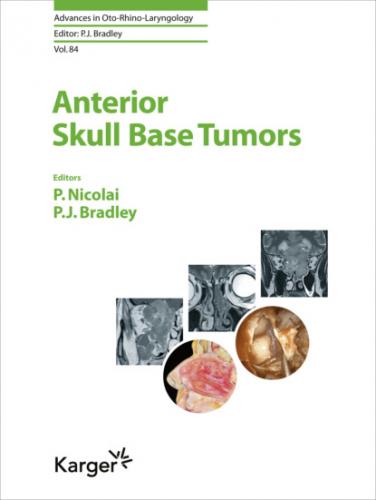Well and Moderately Differentiated (Typical and Atypical Carcinoid)
Histologically, carcinoid tumours are composed of organoid structures, including cell nests, glandular structures, and cords of monotonous basaloid cells with a clear or granular cytoplasm [26]. Atypical carcinoid lesions also exhibit these organised features, but there is evidence of mitotic activity, cellular pleomorphism, and necrosis.
Table 2. Ancillary markers in the differentiation of malignant small cell tumours of the skull base
Poorly Differentiated (Small and Large Cell)
Large and small cell carcinomas are generally composed of undifferentiated cells with a high nuclear to cytoplasmic ratio, high mitotic index, and necrosis.
Differential Diagnosis
The differential diagnosis of these tumours depends on their state of differentiation. For carcinoid and atypical carcinoids it may include adenocarcinoma and pituitary adenoma [27–31]. For small cell neuroendocrine carcinoma, a list of small undifferentiated tumours of different lineages should be included in the differential diagnosis. Immunohistochemical, molecular as well as histomorphologic characteristics should be integrated [32, 33].
Teratocarcinosarcoma
This is a rare skull base and sinonasal tract malignant tumour composed of high-grade carcinomatous, sarcomatous, and immature neural elements [34, 35]. Benign and malignant germ cell elements may also be present. The most frequent sites are the ethmoid, maxillary sinus, and nasal cavity in elderly male patients. The carcinomatous component can be either squamous, adeno, or neuroendocrine, and the sarcomatous can be cartilaginous, bony, or skeletal muscle in nature. Neural elements may contain primitive rosettes with neurofibrillary features [36].
Differential Diagnosis
Especially on limited diagnostic material, the differential diagnosis with sarcomatoid carcinoma and hybrid epithelial and mesenchymal neoplasms may be challenging. Immunohistochemical evaluation of lineage markers including neuroendocrine, p63, and OCT3/4 can be used to highlight the corresponding components.
Sinonasal Adenocarcinomas
There is a spectrum of primary adenocarcinomas originates from either the respiratory epithelium or the underlying seromucinous glands of the sinonasal region (Table 3) [37, 38]. Tumours of respiratory epithelial derivation are frequently located in the nasal cavity and the ethmoid sinus, while those arising from the subepithelial glands frequently affect the nasal cavity and maxillary sinus [39–43]. Grossly, tumours are ill-defined, infiltrative, light tan, and soft [43].
Intestinal-Type Adenocarcinoma
Intestinal-type adenocarcinoma is typically encountered in the sinonasal tract, and its differentiation features are similar to those of adenocarcinomas affecting the intestinal tract. These tumours arise in patients with a history of exposure to hard woods, leather, and certain chemical manufacturing [37–39], and specifically develop in the ethmoid and nasal cavity. Histologically, intestinal-type adenocarcinoma mimics colonic and gastric adenocarcinomas and show significant mucinous and signet-ring features. Seromucinous adenocarcinoma is typically low-grade, with back to back cuboidal lined glands and cords [40–43].
Table 3. Skull base adenocarcinomas
Differential Diagnosis
Sinonasal adenocarcinomas should be differentiated from metastases to the skull base due to salivary and intestinal primaries.
Salivary Gland-Derived Carcinomas
The most frequent phenotype affecting this region is adenoid cystic carcinoma. Adenoid cystic carcinoma typically displays a tubular, cribriform, or solid (or basaloid) pattern. In most adenoid cystic carcinomas, all three patterns can be present, although the distribution greatly varies between different tumours, and even in different areas within the same lesion.
Differential Diagnosis
A diagnostic challenge is mainly encountered with the solid form of adenoid cystic carcinoma, which needs to be differentiated from basaloid squamous carcinoma, malignant melanoma, and neuroendocrine carcinoma. p63 and p40 positivity may direct the diagnosis towards basaloid squamous carcinoma, though this finding can also be present in the myoepithelial component of adenoid cystic carcinomas which has a dual cell population in the tubular and cribriform pattern. Solid adenoid cystic carcinoma is typically derived from the duct-like component and is therefore negative for p63 expression or may show rare positive peripheral cells. Melanoma is positive for melan-A, HMB45, and tyrosinase staining.
Seromucinous Gland-Derived Carcinoma
They are generally low grade and mimic their origin from seromucinous minor glandular structures lining the respiratory mucosa of the ethmoid and maxillary sinuses.
Benign Tumours
Inverted Papilloma
Inverted papilloma is characterised by an inward growth of squamous papilloma with transitional epithelial structures. This lesion is more common in males than females and has a propensity for recurrence and malignant progression. The detection of dysplasia and/or squamous differentiation (keratinisation) is a feature considered to predict malignant transformation. Grossly, inverted papillomas
